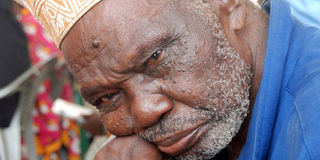TJRC blames former regimes for killings

PHOTO | FILE Mzee Ali Said from Likoni follows proceedings during the TJRC hearings at the Tononoka Social Hall in Mombasa in January.
What you need to know:
- Truth team calls for fresh probe into the death of Ouko
The truth commission wants the Kenyatta and Moi governments to take responsibility for the political assassinations of the late Pio Gama Pinto, Tom Mboya, JM Kariuki and Robert Ouko.
In a report handed to President Uhuru Kenyatta on Tuesday, TJRC also recommends that the government re-opens investigations into Dr Ouko’s assassination in February 1990.
The report details striking similarities in the murders of Mr Pinto, Mr Mboya, Mr Kariuki and Dr Ouko, pointing a finger at political assassinations and complex cover-ups, including the murder of key witnesses.
It states that Mr Pinto’s murder in cold-blood on February 25, 1965, was intended to forestall a policy paper on African socialism that he had been tasked to draft by Jaramogi Oginga Odinga, then Vice-President, to counter the official government position on the matter.
“Had this plan come to fruition, it could have made Pinto the architect of the first parliamentary coup and thus the man closest to organising a real political revolution in Kenya,” the report states.
The report captures a bitter exchange between then Information Minister Achieng Oneko and then President Kenyatta when the news of Mr Pinto’s murder broke out.
“Information Minister Achieng Oneko reacted to the news with: ‘No, no, no! Kenyatta must explain! He must explain!’. President Kenyatta retorted ‘Bwana Waziri do you think it is Kenyatta who has killed Pinto?’”
The report quotes Mr Mboya’s convicted killer, Nahashon Isaac Njenga, implicating Mzee Kenyatta in the assassination plot.
“When he was arrested, the murder weapon was found in his house in Ofafa Jericho. Assistant Superintendent of Police Joginder Singh Sokhi asked Njenga: ‘Is this the gun that killed Mboya?’, Njenga retorted: ‘Why don’t you ask the big man? We did what we were told’.”
The report also blames JM’s murder on a powerful clique around State House who viewed him as a popular alternative to Mzee Kenyatta.
“Like Mboya, he was increasingly viewed as a popular alternative to President Kenyatta and his inner circle,” it states.
It details the circumstances leading to JM’s death, including a ban from addressing gatherings in colleges and rallies in his constituency and the confiscation of his pistol by state security agents.
The report describes the murder of Dr Ouko as one of the most gruesome events that characterised retired President Daniel arap Moi’s 24-year rule.
“His body was found badly burnt, but the face was recognisable. His arms and legs had been smashed. A bullet had passed through his skull. There were no signs of struggle near Nyando River at the foot of Got Alila Hills where his body was discovered by a 13-year-old boy,” the report states.
His body was discovered on February 16, 1990.
Spearheading cover-up
The report accuses then chief government pathologist Dr Jason Kaviti of spearheading attempts to cover-up the murder.
“He initially claimed Ouko’s broken leg was due to the heat of the fire, then later attributed it to blunt force trauma. The actual cause of death was a gunshot wound to the head, which, according to Dr Kaviti, was self-inflicted,” the report states.
The report recommends that a new investigation into the murder be opened with a brief to revisit a warning that went out urging the Kenyan delegation not to go to Washington; a car accident that occurred days before Dr Ouko’s disappearance and a strange woman who placed threatening calls to Dr Ouko’s wife and girlfriend.




